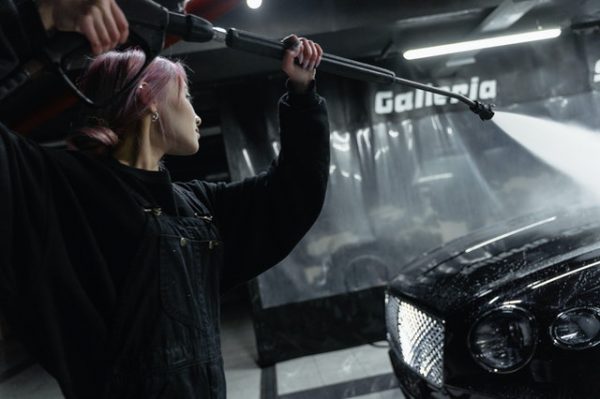In the winter, many cities use salt to help melt ice and snow on roads. However, salt can also damage a car’s undercarriage. Over time, salt can corrode metal parts, causing rust and other problems. In addition, salt can also damage rubber and plastic components. So how can you protect the undercarriage from salt?
In this article, I will show you an easy method to protect the landing gear from salt. This will keep your car looking new for many years. Read on to learn more about the procedure.
To protect the undercarriage from salt, you will need to park the vehicle, raise it with a jack and jack stands, remove all four wheels, wash the undercarriage, let it dry, sand the metal parts, and apply a spray base coat.
Main point
How to protect the undercarriage from salt
Get yourself a professional quality base coat spray
Park the car on level ground
Jack the front and rear of the vehicle
remove the wheels
wash landing gear
Sand the metal parts
Apply the base coat spray
Prevent coatings from coming off by inspection and spraying
How to protect the undercarriage from salt
Protecting the undercarriage from salt requires putting a good solid coating on it. When the metal and plastic parts under your vehicle have a coating, the salt will never reach them and will not corrode them. Here’s how to protect the undercarriage from salt:
Note: Regardless of whether you live in an area where it never snows and the city uses salt on the roads, you should still do this. You could be living in a salt water atmosphere (near an ocean or sea) and the salt will still get on the metal parts of your vehicle and cause them to rust.
1. Required materials
wire brush or sandpaper
Professional Grade Base Coat Aerosol (see internet.com for prices)
Protective equipment (mask, glasses, gloves)
car jack and jack stands
Spanner
2. Park the car on level ground
This task will take up to five hours of work, so plan ahead. The vehicle must be parked on level ground to begin with because you will need to lift the front and rear of the vehicle in order to get under the vehicle.
In addition, the time required for the work must be taken into account. If you want to get things done in one day, plan where you will be able to complete this task. If you start very early in the morning, you can probably take advantage of the sunlight. However, if you plan to start in the afternoon, park the car in a garage or have a light source ready.
But anyway, park the vehicle on level ground and make sure the parking brake is on.
3. Jack the front and rear of the vehicle
Protecting the undercarriage from salt requires several tasks, including washing the underbody, sanding it, and applying the coating. This means that the vehicle must be raised. To safely perform this task, raise both the front and rear of the vehicle with a jack, then attach jack stands for safety. You can find the lifting points in your owner’s manual. Raise the vehicle high enough that you can climb under it and work on it.
4. Remove the wheels
Removing the wheels can be a step that adds a bit of work to it. But believe me, removing the wheels will give you much more access and you can cover a very important part of the vehicle where snow, salt and ice settle. it’s the fender. As you drive your car, snow is thrown backwards by the tires and accumulates on the fenders. This is actually the number one area when it comes to rust damage.
To remove wheels from a car, you will need a lug wrench to loosen the lug nuts. Since the vehicle is already raised, use the lug wrench to loosen the lug nuts. Remove all nuts and save. At this point, you should be able to take the wheels off and store them to the side. Sometimes the wheels can get stuck and not come off immediately. Move them gently back and forth. Make sure you don’t use a lot of force because your car is on jack stands and you don’t want the car to fall off the jack stands.
5. Wash the undercarriage
The best way to wash a car’s undercarriage is to use a pressure washer. First, be sure to lower your washer’s pressure setting, as high pressure can damage sensitive components. Then aim the nozzle up and move it back and forth across the underside of the car. Start from the front and work your way to the back. Be sure to pay special attention to areas that are particularly dirty or likely to corrode.
However, if you don’t have a pressure washer, you can use a garden hose. However, since all sorts of things get under your vehicle, you may also need a brush to help you remove stubborn dirt. Since you will be using a brush, you can also soak it in some soapy water. Just make sure you rinse it really well afterwards. We don’t want the soap to interfere with the base coat.
6. Sand the metal parts
It is very important to sand your vehicle’s chassis before applying a base coat. By sanding the metal parts, you are actually removing excess rust and dirt. This will allow the bottom layer to adhere more easily to the metal surface and better protect it.
Sanding the undercarriage of a car is not a difficult task. First, you will need to gather some supplies. You will need various grit sandpaper, a dust mask, eye protection, and a power sander. If you don’t have an electric sander, you can also do this by hand using sandpaper or a wire brush.
Next, start with a coarse grit sandpaper and work your way up to a finer grit. The key is to take your time and be careful not to damage the metal. When you finish sanding, be sure to clean the area of any dust residue.
7. Apply base coat spray
At this point, the undercarriage should be washed, dried, and sanded. If this is the case, it’s time to apply the base coat spray. Take the base coat spray and shake it well before using it. You can start from anywhere. Personally, I always start from behind the wheel. I do all four wheels first and then I move under the vehicle. Be sure to spray base coat on all metal parts. Don’t worry if you get some of the spray basecoat on things like plastic, bumpers, thumbtacks, wiring, etc. This material is non-abrasive and will not harm them.
The biggest mistake people make here in this step is not having enough base coat sprays. If you’re doing this for the first time, you might know how many apps you need. That’s why it’s better if you get a six pack. You will also need the base coat spray for next time.
8. Prevent Liners From Peeling Off
We all know that while driving, a lot of things get under the car and can chip the basecoat. In places where there is no base coat, the metal is not protected from salt. That’s why it’s important to get under the vehicle from time to time and inspect the condition.
Your undercarriage will be protected from salt as long as you prevent the liners from rubbing or cracking. If you’re in an accident and don’t reseal the liner, your car won’t be protected from salt.
Where should you not spray base coat?
It is important to apply a base coat to your car to protect it from corrosion, but you should avoid spraying the base coat on certain parts of the car. The base coat can trap moisture and cause rust. You should avoid spraying basecoat on brake rotors, brake drums, rubber, sensors, tubes, driveshaft, tires, and parts that get hot like the exhaust and engine.




